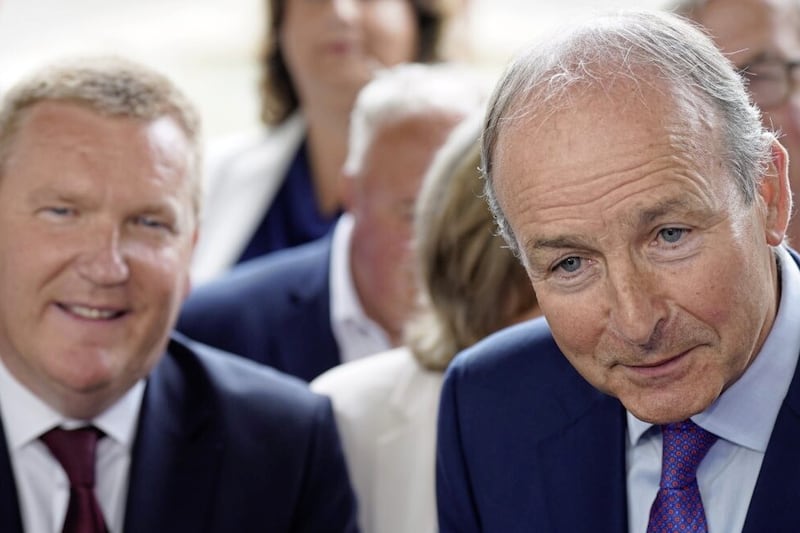On Saturday, over 48,000 American football fans will gather at Dublin’s Lansdowne Road stadium for the college football season opener between the University of Notre Dame’s 'Fighting Irish' and the US Naval Academy’s 'Midshipmen'.
Forty thousand of those spectators will travel from the USA for the game, the third time the teams have met on Irish soil.
I am mother to a fourth generation University of Notre Dame 'Subway Alumnus' and one of those 40,000 travelling fans is staying in my house this week.
Read more:
Patricia MacBride: Lord Kilclooney tweet shows GAA brings out the best in all of us
Patricia MacBride: Lessons for life from Barbieland
There is something unique and special about Notre Dame football in the Irish-American psyche that draws families and communities together in a way that I don’t think any other amateur sport in the USA does.

If Notre Dame was a GAA county team, then the Dubs may wave goodbye to Hill 16 because it would be overrun.
The story of how Notre Dame became known as the Fighting Irish is an interesting one.
South Bend, Indiana did not have a particularly large Irish community, but as one of America’s few Catholic universities, Notre Dame did attract the children of Irish immigrants who had prospered in the USA.
During the 1910s and 1920s, stereotypes and ethnic slurs were openly expressed against immigrants, Catholics and the Irish in the media and in public.
It was the era of legendary football coach Knute Rockne, a Norwegian immigrant, who began to coin the phrase Fighting Irish to highlight the underdog tenacity of his team. He turned a taunt into an expression of confidence and gradually the newspapers of the day began to pick up on it.

Likewise, the team’s mascot, the leprechaun, was chosen as a deliberate move to reclaim the caricature status it had been given by the English and subsequently the American WASP colleges.
Notre Dame’s reputation was cemented in 1924 when the Ku Klux Klan announced a plan to hold a parade and rally in South Bend, targeting college campuses for recruitment.
Ignoring the pleas of the college staff to remain on campus, a large number of students confronted the Klan in violent clashes that lasted for three days. In his book Notre Dame vs The Klan, Todd Tucker describes how a weekend of riots drove the Klan out of South Bend and helped bring an end to its rising power in Indiana at a time when the state’s governor was among its members.
Notre Dame had a reputation for travelling to play at a time before widespread air travel and as early as 1915, a former student named Joe Byrne started organising train trips the 60 miles from Manhattan to West Point Military Academy to watch Notre Dame take on Army.

When that game moved to Yankee Stadium for 21 years from 1925-46, the Number 4 subway train would be packed with “Subway Alumni” – people who had never attended the college but felt an affinity to the team because of its Irish identity.
These were Irish immigrants, or the children of immigrants, who sought each other out and came together to support a team that was an illustration of the American dream, bringing together both a college education and sporting success.
It was a loyalty passed on through generations and the reason why I found myself in South Bend for the opening game of the 2017 season, caught up in a weekend of pep rallies, tailgate parties, and post-game celebrations.
Given Notre Dame’s strong ties to Ireland, the following day they showed the All-Ireland hurling final in the college theatre. I met a student from Derry there named Conal Fagan, who subsequently went on to become the college’s mascot. For the duration of the role, he became known as LepreConal, a nickname which he will no doubt carry his whole life.

Saturday is a postponement of the game which was to take place in 2020 and was cancelled due to Covid-19. That was to be a home game for the Naval Academy team but there is no doubt they will be massively outnumbered by the away fans.
As well as the teams, marching bands, cheerleaders, coaches and travelling fans, around 20 members of Congress and a handful of Supreme Court Justices are expected to attend as well.
In the tradition of American football games, this truly is a homecoming. It is the spirit and ethos of embracing the diaspora, of welcoming visitors and a fulfilment of a promise to generations of fans.
It’s proof that you don’t have to be from Ireland to be Irish.







